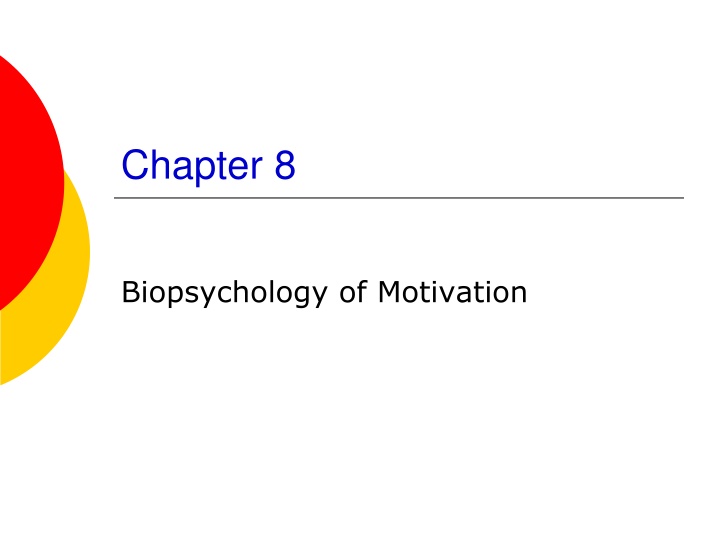
Biopsychology of Motivation: Understanding Drives, Incentives, and the Role of the Hypothalamus
Explore the biopsychology of motivation, including drives, homeostasis, regulatory and non-regulatory drives, digestive processes, and the role of the hypothalamus in hunger and satiety. Understand how internal and external factors influence behavior and goal orientation.
Download Presentation

Please find below an Image/Link to download the presentation.
The content on the website is provided AS IS for your information and personal use only. It may not be sold, licensed, or shared on other websites without obtaining consent from the author. If you encounter any issues during the download, it is possible that the publisher has removed the file from their server.
You are allowed to download the files provided on this website for personal or commercial use, subject to the condition that they are used lawfully. All files are the property of their respective owners.
The content on the website is provided AS IS for your information and personal use only. It may not be sold, licensed, or shared on other websites without obtaining consent from the author.
E N D
Presentation Transcript
Chapter 8 Biopsychology of Motivation
Motivation and incentives Motivation factors within and outside an organism that cause it to behave a certain way at a certain time Motivational state or drive an internal condition, which can change over time, that orients an individual to a specific set of goals (e.g. hunger, thirst, sex, curiosity) Incentives goals or reinforcers in the external environment (e.g. good grades, food, a mate)
Drives as tissue needs Homeostasis the constancy of internal conditions that the body must actively maintain Drives may be an upset in homeostasis, inducing behaviour to correct the imbalance Animals do behave in accordance with their tissue needs (e.g. increasing or decreasing caloric intake, drive for salt) However, homeostasis cannot explain all drives
Types of drive Regulatory drives helps preserve homeostasis (e.g. hunger, thirst, oxygen) Non-regulatory drives serve other purposes (e.g. sex, achievement)
The digestive process 3 nutritional substances: carbohydrate, fat & protein Made into bolus Breakdown by enzymes Absorption in small intestine Excretion
Eating Glucose is absorbed by the duodenum Blood glucose level rises Triggers the pancreas to release the hormone insulin Insulin boosts the glucose uptake from the blood into the liver Where the glucose is not required for immediate energy, it is converted into glycogen and stored This can later on be converted back into glucose, as needed Any excess glucose (fat) is stored in adipose tissue
The role of the hypothalamus in hunger and satiety Lateral hypothalamus initiates eating LH-lesion syndrome Aphagia lack of eating Adipsia lack of drinking Ventromedial hypothalamus suppression of eating VMH-lesion syndrome Hyperphagia obesity due to overeating
The role of the hypothalamus in hunger and satiety Arcuate nucleus travels to the paraventricular nucleus of the hypothalamus The paraventricular nucleus is a part of the hypothalamus that inhibits the lateral hypothalamus which is vital for feelings of hunger and satiety Axons from the satiety-sensitive cells of the arcuate nucleus deliver an excitatory message to the paraventricular nucleus which triggers satiety
The role of the hypothalamus in hunger and satiety Input from the hunger-sensitive neurons of the arcuate nucleus is inhibitory to: The paraventricular nucleus and The satiety-sensitive cells of the arcuate nucleus itself inhibitory transmitters include GABA neuropeptide Y (NPY) agouti-related peptide (AgRP) Neuropeptide Y (NPY) and agouti-related peptide (AgRP) are inhibitory and block the satiety action of the paraventricular nucleus and encourage overeating
The role of the hypothalamus in hunger and satiety Paraventricular nucleus acts on the lateral hypothalamus The lateral hypothalamus controls insulin secretion and alters taste responsiveness Animals with damage to this area refuse food and water and may starve to death unless force-fed
Non-neural control of eating behaviour Peripheral cues Oral cues taste Stomach cues distention cue for termination
Non-neural control of eating behaviour Hormonal satiety cues Cholecystokinin (CCK) neuropeptide hormone produce satiety Glucostatic principle blood sugar level important Glucoreceptors in liver & hindbrain detect low blood sugar level Pancreas releases insulin Lipostatic theory metabolize fatty acids Ghrelin A hormone produced mainly by P/D1 cells lining the fundus of the human stomach Ghrelin levels increase before meals and decrease after meals
Environmental factors of eating Hunger cannot, in reality, be understood with just the biological component Individuals (whether or not they are obese) react to external cues Time Likes/dislikes
Obesity & long-term control of body weight Obesity is defined as BMI of 30 or greater The Lipostatic theory fat metabolism circulating in the blood acts as a signal to the hypothalamus Hormone leptin is concerned with long-term weight control feedback loop High leptin indicates sufficient energy reserves and low amounts indicate hunger mode Leptin also minimizes the impact of NPY promotes alpha-melanocyte-stimulating hormone (a-MSH) which also reduces appetite increase the effects of appetite suppressants like cocaine- amphetamine-regulated transcript (CART), bombesin and corticotropin-releasing factor (CRF) Obese people in general have a resistance to these high levels of leptin
Set point theory We have a set weight, determined by the hypothalamus that the body tries to maintain (Keesey & Powley, 1986) Body itself works to maintain that set point Damage to the VHM might raise the critical set point
Genetics and overweight Leptin, the protein hormone encoded by the ob gene Mice with mutations on both ob genes (ob/ob mice) are unable to synthesize leptin Lack of leptin results in overactive neuropeptide Y neurons and hyperphagia and obesity, which mirrors VMH or PVN damage Genetic mutations that cause defects in the leptin synthesis and lepin receptors give rise to db/db mice In fa/fa Zucker rats that have defective leptin receptors lepin has little influence on food consumption It is quite unusual to find a double mutation for the leptin or leptin receptor genes in humans
Eating disorders Anorexia nervosa Severely underweight, and have a distorted body image and an obsessive fear of putting on weight Mortality rate varies 5 20% of individuals with this disorder die from starvation or medical complications Bulimia nervosa Refers to binge eating followed by compensatory behaviour such as self-induced vomiting, fasting or excessive exercise 90% of those diagnosed with bulimia nervosa are women, and most report that the illness began somewhere between the ages of 12 and 25 People suffering from the disorder secrete abnormally low levels of Cholecystokinin (CCK)
Thirst Water constitutes 70% of the mammalian body Water in the body must be regulated within narrow limits The concentrations of chemicals in water determines the rate of all chemical reactions in the body
Drinking-dry mouth theory In 1934, Walter Cannon suggested that people feel thirsty because their mouths get dry Recent research contradicts this theory Where animals can drink but the water does not enter the stomach Thirst is only temporarily lessened Must be other factors that are involved in determining how much water we drink
Thirst Two different kinds of thirst include: Osmotic thirst a thirst resulting from eating salty foods Hypovolemic thirst a thirst resulting from loss of fluids due to bleeding or sweating 1. 2.
Osmotic thirst Osmotic thirst occurs because the human body maintains a combined concentration of solutes at a fixed level of .15 M (molar) Solutes inside and outside a cell produce osmotic pressure low solute concentration to an area of high solute concentration Occurs when solutes are more concentrated on one side of the membrane
Osmotic thirst The brain detects osmotic pressure from: Receptors around the third ventricle The OVLT (organum vasculosum laminae terminalis) and the subfornical organ (detect osmotic pressure and salt content) Receptors in the periphery, including the stomach, which detect high levels of sodium
Osmotic thirst When receptors are stimulated: The posterior pituitary releases Antidiuretic hormone (ADH) or vasopressin. Vasopressin is a hormone which raises blood pressure by constricting blood vessels to compensate for the decreased water volume ADH causes kidneys to reabsorb water and excrete highly concentrated urine
Hypovolemic thirst Is associated with a low volume of body fluids Is triggered by the release of the hormones vasopressin and angiotensin II Angiotensin II formed from angiotensin I by the angiotensin- converting enzyme (ACE). Angiotensin II constricts the flow of blood, increases the release of ADH Angiotensin II stimulates neurons in areas adjoining the third ventricle Triggers the hypothalamus to activate the thirst reflex, resulting in a higher blood pressure
Reproductive behaviour Two X chromosomes (XX) for females and X and a Y (XY) for males. Y chromosome in males includes SRY (the sex determining area on the Y chromosome) gene results in the gonads developing into testes testosterone A peptide hormone m llerian-inhibiting hormone (MIH) results in the degeneration of the m llerian ducts which, in women, continue to develop into the Fallopian tubes, the uterus and part of the vagina Research in this area has suggested that testosterone results in the development of the mascularized brain
Early effects of testosterone Presence of testosterone during critical period will cause rudimentary genitals of fetus to develop into male structures Testosterone acts in the brain to promote the development of neural systems for male sex drive and inhibit systems for female Absence of testosterone causes development of female structures
Sex differences in the brain Sexual responses are associated with the hypothalamus and the limbic system, but no specific sex centre Structural differences can be seen in the preoptic regions of the hypothalamus, known as the sexually dimorphic nucleus (SDN) Males have more SDN than females The number of cells in the SDN drops significantly in males over the age of 50 One study reported sex differences in the corpus callosum, reporting greater connectivity between the two hemispheres of the brain in women. This was controversial
Role of SDN in sexual behaviour Male sexual behaviour occurs in two phases: appetitive stage consummatory stage Medial preoptic region of the brain is involved in both stages Lesions to the SDN-POA cause an extreme disruption to the copulatory activities of rats Lesions of SDA sexually dimorphic area (SDA) pars compacta in gerbils severely disrupt male copulatory behaviour
Readings Barnes, J. (2011). Essential Biological Psychology (Chapter 8). London: Sage. The Essentials Franken, R.E. (2001). Human Motivation (4th edn). Pacific Grove, CA: Brooks/Cole. Next Steps Friedman, J.M. (2002). The Function of leptin in nutrition, weight, and physiology. Nutrition Reviews, 60, S1-S14. Delving Deeper Bishop, K.M., & Wahlsten, D. (1997). Sex differences in the human corpus callosum: myth or reality? Neuroscience and Biobehavioral Reviews, 21(5), 581-601.






















